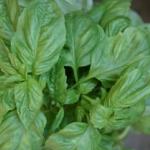Downy Mildew of Basil
Signs and Symptoms
Leaf yellowing is often the first symptom of basil downy mildew. Yellowed areas are usually bordered by leaf veins. When spores are produced, a characteristic fuzzy, dark gray to purple growth on the underside of the leaves is evident. Sporulation on the upper surfaces of leaves may be seen in severe cases. Symptoms of downy mildew on basil can easily be mistaken for a nutritional deficiency. The fuzzy growth of spores on the underside of the leaf may look as if soil had been splashed onto the leaf under-surface.
Disease Cycle
Spores are produced in darkness before sunrise. Sporulation occurs at 50-78°F and >85% relative humidity (RH). Spores are borne at the ends of tiny tree-like structures called sporangiophores which grow out of the stomata. The spores are dispersed by wind and splashing water. On wet leaves at temperatures from 41 to 83°F, spores germinate within 2 hours and infect plant tissue within 4 hours. Five to 10 days may elapse between infection and the appearance of symptoms; the duration of the latency period depends upon temperature and light exposure. Basil downy mildew is unable to survive winter temperatures in the northeastern US.
Cultural Management
The most important environmental factors favoring disease development are high humidity and extended leaf wetness. These factors can be reduced by:
- Toward evening, heat and vent the greenhouse, especially when warm days are followed by cool nights.
- Improve horizontal air flow by the use of fans.
- Run fans at night. Fans may be connected to sensors that will turn them on when the RH reaches 70% and turn them off when it drops below 65%.
- Reduce plant canopy density by spacing to speed leaf drying.
- Water in the morning, if practical, or use drip irrigation rather than overhead.
- While sporangiophores can be formed in light or darkness, spore production requires a period of darkness. Exposing infected plants to red light (λ 575-660 nm) at night inhibits spore production. Some crop loss may be incurred, as sporangiophores can still emerge from the leaves; however, the reduction in spore production can help prevent the pathogen from spreading to uninfected plants.
- Space plants to enhance leaf drying.
- Grow tolerant or resistant cultivars. Classic Genovese types of basil are highly susceptible to downy mildew. ‘Eleonora’, ‘Everleaf’, “Tuscany’, and ‘Caesar’ are considered tolerant. Resistant cultivars include 'Amazel', 'Prospera', and the Rutgers series 'Devotion', 'Obsession', 'Passion', and 'Thunderstruck'.
Chemical Management
Few fungicides are labeled for herb plants and there are differences in registrations for field grown plants versus greenhouse plants. Check the labels on individual products. Copper products, phosphites, cyazofamid, mandipropamid, oxathiapiprolin, and azoxystrobin are labeled for use on basil. Many organic products are also labeled for use on basil but efficacy data is lacking. Both conventional and organic products should be used in a preventative manner to protect plants from infection, as few have any curative properties. Consult the New England Vegetable Management Guide for a full listing of products.
It is the grower’s responsibility to read and follow label instructions. Be sure that a particular product is registered for use in your state. The label is the law and any recommendations made here are superseded by the label.

